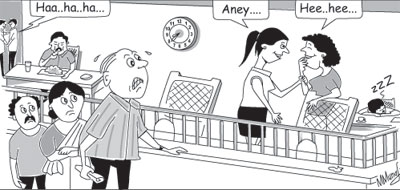Letters to the editor
View(s):Apathy towards Sansoni Commission main reason for Black July
Black July 1983 received worldwide attention. In spite of all the publicity it took 18 long years for the government to appoint the Truth Commission. In fact Black July could easily have been avoided but for that we need to go back to the 1977 communal disturbances which took place during the period August 13 to September 15.

I write from firsthand experience because my brothers and sisters, their family members and I were all victims. The incidents that occurred during this period were of such an extreme nature and so widespread that President William Gopallawa appointed a Commission of Inquiry under Section 2 of the Commission of Inquiry Act immediately after on November 9, 1977.
The Commission commonly referred to as the Sansoni Commission commenced its sittings on February 8, 1978 and concluded on December 10, 1979. The sittings were held over 298 days as follows: Jaffna -8.2.78 to 11.4.78, Anuradhapura -24.4.78 to 29.4.78, Kandy -15.5.78 to 21.7.78, Colombo- 7.8.78 to 25.9.78, Trincomalee- 2.10.78 to 28.10. 78, Colombo- 15.11.78 to 15.6.79, Kandy 25 .6.79 to 25 .7.79, Kandy- 22. 10.79 to 10.12.79.
The Commission Report runs into 277 pages. 952 victims and witnesses gave evidence. Apart from that 275 affected persons had filed affidavits. A number of organisations led by eminent legal counsel also gave evidence. I was the first to give evidence at the Commission’s first sitting in Kandy. At the time I was an employee of the Local Government Service and working in the Kandy Municipal Council.
It is a great pity that so much of valuable material, prepared in detail after hearing the evidence of victims as well as public persons and organisations concerned with the welfare of the people and the country as a whole was not used properly and effectively. The Commission Report is filed as a Sessional Paper-No Vll-1980. A Committee was appointed in terms of a Cabinet decision for the payment of compensation for loss and damage to private property and injuries caused to private persons. It comprised L.M. Ismail, retired Supreme Court Judge as Chairman, B.L Ariyatilake, Chief Valuer of the Valuation Department and P. Lakdawela, Staff Officer, Central Bank. P.A. Abeywickrema was appointed Secretary to the Committee. Victims of the communal disturbances were informed that a notice would be published in the newspapers, that they could present their submissions to the Committee. The Notice did not appear; the Committee did not sit; Compensation was not paid. (Sunday Times- March 18, 1990).
Chapter VI of the Sansoni Commission Report deals with the subject covered by Section 3(b) of the terms of reference- ‘Measures necessary to ensure the safety of the public and to prevent the recurrence of such incidents’. Had these measures been taken, Black July 1983 could have been a non event. Hooligans in mobs went on the rampage while a continuous curfew was on for three days. Our belongings were looted in broad daylight and at 8 p.m. fires were lit to burn houses. What I have stated above, I have submitted in writing to the Truth Commission and supported same by oral evidence.
S. Thambyrajah, Kandy
Speed breakers a good solution
I wholeheartedly endorse the view expressed by Mr.Bernard Fernando of Moratuwa in the Sunday Times of July 7, regarding safety at unprotected Railway crossings.
A concrete speed breaker on either side of the crossing is a useful alternative. Vehicles approaching the speed barrier will be forced to slow down and in the process, the driver will be able to either see or hear the train approaching the crossing thereby avoiding an accident. Some vehicles like motor cycles and three wheelers are known to go through the gaps even in the protective gates. Speed breakers are useful even in the presence of protective gates.
K.Alagaratnam, Wellawatte
CMC : Who’s to blame for the mess?
On a recent visit to the Colombo Municipal Council’s Town Hall premises, a few CMC officers and I were stopped at the entrance by the security guard as the National Flag was about to be hoisted by a few individuals including security guards. The time was already 8.40 a.m. The person who was getting ready to hoist it looked like a politician and I asked the person what the name of the MMC was. He smiled and told me that it was not an MMC but a driver attached to the CMC who is given the task of hoisting the flag if no one else was available and added that for this purpose he was given an extra 100 hours of overtime.

He showed me the newly laid drains just there which were filled with rain water and said that despite spending millions of rupees given to the CMC by the World Bank the drains were still blocked and no one was bothered.
I remember as a child the Town Hall lawn was so beautifully laid with light greenish thick grass but the new grass is of different hues of green and looks like any wild grass that is found everywhere. Interesting to know how much was paid to the contractor for the service. There were labourers trying to pick out the ‘nidikumba plants’ which were planted with the grass.
Once inside the Town Hall I was directed to the counter by the receptionist in a skirt and blouse to make my payment of rates but the staff was nonchalantly talking among themselves oblivious of the crowd that was gathering to pay the rates. Some inside were having their breakfast huddled around tables. The place looked awfully dusty and poorly lit. Although the outer walls of Town Hall are painted yearly spending millions of rupees, inside there is hardly any work being done. There are no seating facilities for the customers and we had to wait until everyone was ready to work.
Then I found that I was in the wrong queue. Being a diabetic patient I needed to use the toilet. I was directed by a security guard to a smelly toilet near the Planning Department. I decided not to enter it. After I got back to my place in the queue the security guard told me that absolutely no maintenance work is done and that they had forgotten to repair the roof when the colour washing was started and now that also has stopped until the roof repairs are done.
Coming out of the Town Hall I noticed the destruction that is being done in the name of beautification around the Buddha statue completely destroying the serenity that we enjoyed all these years. I wonder who is behind this.
I can’t understand why the CMC cannot get the advice of some prominent Buddhist priests without deciding on their own as this has been a place enjoyed by locals and tourists alike.
N. Bandara, Via email
Follow @timesonlinelk
comments powered by Disqus


